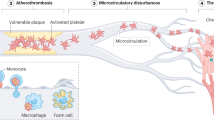Abstract
Platelet activation subsequent to the adhesion of platelets to the vascular wall results in the release of mediators that promote platelet aggregation, which plays a pivotal role in the development of the polyvascular atherosclerotic disease that can be referred to by the acronym ‘ATIS’ (AtheroThrombosIS). The currently available antiplatelet drugs used to prevent vascular events in patients with cardiovascular disease, including peripheral arterial disease (PAD), include aspirin and thienopyridines such as clopidogrel. These drugs decrease platelet aggregability, each of them by inhibiting a different pathway of platelet activation and recruitment. Aspirin acts by inhibiting thromboxane A2 (TXA2) formation through the inhibition (acetylation) of cyclo-oxygenase. On the other hand, thienopyridines suppress the platelet aggregation adenosine diphosphate (ADP) pathway by inhibiting the platelet P2Y12 subtype of the ADP receptor.
The results of the large ATT (Antithrombotic Trialists’ Collaboration) meta-analysis of published clinical studies on aspirin, reported in 2002, confirmed the previous meta-analysis and major trials that treatment with aspirin (mixed with other antiplatelet agents in these large metaanalyses) can prevent vascular events in high-risk patients with cardiovascular disease. However, it must be stressed that specifically in PAD patients no significant effect of aspirin was demonstrated in a more recent meta-analysis. This was also the case for primary and secondary prevention in diabetic patients. In keeping with these observations, neither a five-year follow-up study of Japanese diabetic patients in the JPAD (Japanese Primary Prevention of Atherosclerosis with Aspirin for Diabetes) study, a seven-year follow-up study of UK diabetic patients with PAD in the POPADAD (Prevention of Progression of Arterial Disease and Diabetes) study, nor a very recent Scottish study in the same population of diabetics with PAD revealed a significant beneficial effect for aspirin in preventing ischaemic events. This failure may be a consequence of more rapid recovery of platelet aggregability following each dose of aspirin in these PAD or diabetic populations, with the accelerated platelet turnover resulting in a condition of aspirin resistance.
Results of the large scale CAPRIE (Clopidogrel versus Aspirin in Patients at Risk of Ischaemic Events) trial that evaluated clopidogrel in patients with cerebral infarction, myocardial infarction or PAD have found clopidogrel to be significantly more effective than aspirin in preventing ischaemic events in patients with PAD. Furthermore, a subgroup analysis of the study has confirmed the efficacy of clopidogrel in diabetic patients with PAD, showing a significant reduction of events in clopidogrel-treated, compared with aspirin-treated, diabetic patients. These results are also likely to be attributable to the greater frequency of aspirin resistance in aspirin-treated patients in these populations (diabetics and/or PAD).
Platelets, through activation and aggregation, have an important role in ATIS. However, although antiplatelet therapy with low-dose aspirin has been reported to prevent vascular events in high-risk patients with cardiovascular disease, recent studies in patients with PAD or diabetes mellitus have failed to support the efficacy of aspirin in preventing vascular events in these patient populations. In contrast, clopidogrel appears to be a useful antiplatelet agent in the prevention of vascular events in patients with PAD or diabetes.
Similar content being viewed by others
References
Lechat P, Priollet P. Prevention of major ischemic events in lower limb arterial disease: does aspirin play a role? J Mal Vasc 2006; 31: 129–34
Antithrombotic Trialists’ Collaboration. Collaborative meta-analysis of randomised trials of antiplatelet therapy for prevention of death, myocardial infarction, and stroke in high risk patients. BMJ 2002; 324: 71–86
Cubbon RM, Gale CP, Rajwani A, et al. Aspirin and mortality in patients with diabetes sustaining acute coronary syndrome. Diabetes Care. 2008; 31: 363–5
van der Zee PM, Biró E, Ko Y, et al. P-selectin- and CD63-exposing platelet microparticles reflect platelet activation in peripheral arterial disease and myocardial infarction. Clin Chem 2006; 52: 657–64
Fitzgerald DJ, Maree A. Aspirin and clopidogrel resistance. Hematology Am Soc Hematol Educ Program. 2007: 114–20
Sideris G, Guyetand S, Belluci A, et al. Low dose aspirin does not maintain a 24-hour biological efficacy in type-2 diabetic patients. Eur Heart J 2007; 28(suppl 1): 267
Ogawa H, Nakayama M, Morimoto T, et al. Low-dose aspirin for primary prevention of atherosclerotic events in patients with type 2 diabetes: a randomized controlled trial. JAMA 2008; 300: 2134–41.
Belch J, Maccuish A, Cmpbell I, et al. The prevention of progression of arterial disease and diabetes (POPADAD) trial: factorial randomized placebo controlled trial of aspirin and antioxidants in patients with diabetes and asymptomatic peripheral arterial disease. BMJ 2008; 337: a1840
Fowkes G. Aspirin for asymptomatic atherosclerosis (AAA) study. Presented at ESC congress 2009
CAPRIE Steering Committee. A randomised, blinded, trial of clopidogrel versus aspirin in patients at risk of ischaemic events (CAPRIE). The Lancet 1996; 348: 1329–39
Bhatt DL, Marso SP, Hirsch AT, et al. Amplified benefit of clopidogrel versus aspirin in patients with diabetes mellitus. Am J Cardiol 2002; 90: 625–8
Bal Dit Sollier C, Bergen N, Boval B, et al. Functional variability of platelet response to clopidogrel correlates with P2Y (12) receptor occupancy. Thromb Haemost 2009; 101: 116–22
Author information
Authors and Affiliations
Corresponding author
Rights and permissions
About this article
Cite this article
Drouet, L., Bal dit Sollier, C. & Henry, P. The Basis of Platelets. Drugs 70 (Suppl 1), 9–14 (2010). https://doi.org/10.2165/00000005-000000000-00000
Published:
Issue Date:
DOI: https://doi.org/10.2165/00000005-000000000-00000




